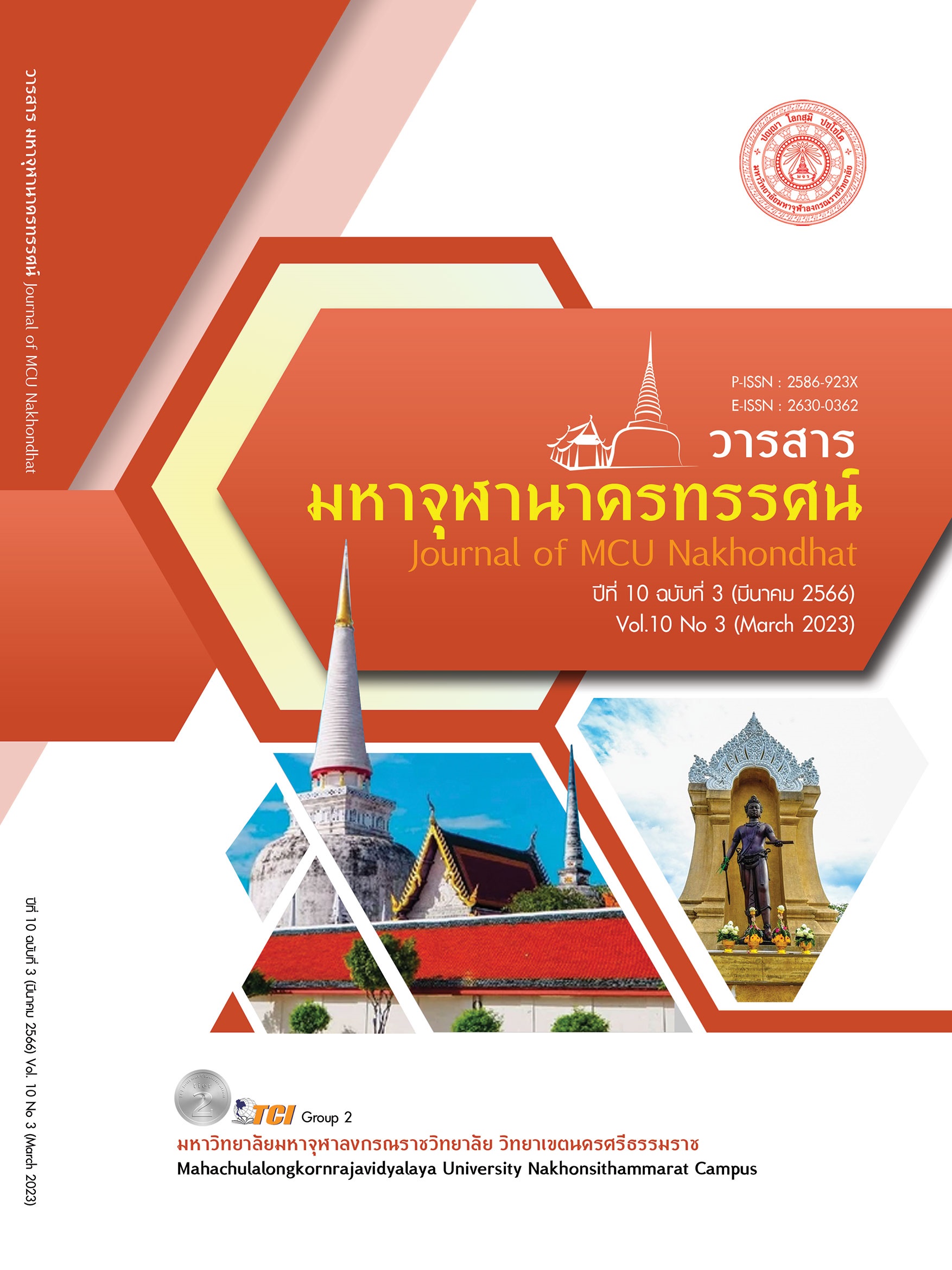EFFECTS OF ACTIVITY BASED LEARNING WITH AUGMENTED REALITY ON SPATIAL SENSE AMONG SEVENTH GRADE STUDENTS
Main Article Content
Abstract
The purposes of this study were: 1) to compare students’ spatial sense of seventh grade students at Srinakharinwirot University Prasarnmit Demonstration School (Secondary) before and after administrating activity based learning with augmented reality; 2) to compare students’ spatial sense of seventh grade students at Srinakharinwirot University Prasarnmit Demonstration School(Secondary) after administrating activity based learning with augmented reality with the criterion of seventy percent. The experimental method is Quasi-Experimental. Research by One Group Pretest–Posttest Design. The sample of this study included 36 of seventh grade students studying in the second semester of 2022 academic year at Srinakharinwirot University Prasarnmit Demonstration School (Secondary). They were selected by using the cluster random sampling technique. The duration of the research was 16 periods. The research instruments consisted of 1) lesson plans; and 2) spatial sense test. The data were statistically analyzed using mean, standard deviation, a t-test for dependent samples and a t-test for one sample. The findings of this study were as follows: 1) the spatial sense of seventh grade students after experiencing activity-based learning with augmented reality were higher than before experiencing the treatment statistically significant at a level of .05. 2) the activity-based learning with augmented reality of the students after experiencing creative activity-based learning with augmented reality were higher than the criterion of seventy percent statistically significant at a level of .05
Article Details

This work is licensed under a Creative Commons Attribution-NonCommercial-NoDerivatives 4.0 International License.
References
โกมล ไพศาล. (2540). การพัฒนาชุดการสอนรายบุคคลด้านเรขาคณิตสำหรับครูคณิตศาสตร์ระดับ มัธยมศึกษาตอนต้น. ใน ดุษฎีนิพนธ์การศึกษาดุษฎีบัณฑิต สาขาวิชาคณิตศาสตร์. มหาวิทยาลัยศรีนครินทรวิโรฒ.
จุฑามณี อินทร์อุริศ. (2563). การจัดการเรียนรู้โดยใช้กิจกรรมเป็นฐานร่วมกับการเรียนรู้แบบร่วมมือ ที่มีต่อความสามารถในการแก้ปัญหาทางคณิตศาสตร์และผลสัมฤทธิ์ทางการเรียนเรื่อง สมการเชิงเส้นตัวแปรเดียว ของนักเรียนชั้นมัธยมศึกษาปีที่ 1. วารสารมหาจุฬานาครทรรศน์, 9(5), 187-196.
ดวงนฤมล ผลศรัทธา. (2563). การจัดกิจกรรมเพื่อพัฒนาความรู้สึกเชิงปริภูมิ. เรียกใช้เมื่อ 21 กุมภาพันธ์ 2565 จาก https://anyflip.com/ivssu/cvhi/basic
ดุสิต ขาวเหลือง. (2561). การพัฒนาสื่อการเรียนรู้สามมิติแบบมีปฏิสัมพันธ์เสมือนจริงโดยใช้เทคโนโลยีความเป็นจริงเสริม Augmented Reality (AR) เพื่อพัฒนาทักษะการคิดของนักศึกษาอาชีวศึกษาที่มีระดับการคิดอย่างมีวิจารณญาณต่างกัน. ใน รายงานการวิจัย. มหาวิทยาลัยบูรพา.
ปานทอง กุลนาถศิริ. (2557). การจัดการศึกษาคณิตศาสตร์ในศตวรรษที่ 21. เรียกใช้เมื่อ 11 เมษายน 2565 จาก https://opac.kku.ac.th/catalog/BibItem.aspx?BibID =b00397689
มยุรัตน์ ธินะ. (2552). การพัฒนาความรู้สึกเชิงปริภูมิของนักเรียนชั้นมัธยมศึกษาปีที่ 1 โดยการใช้สื่อประสม. ใน วิทยานิพนธ์ศึกษาศาสตรมหาบัณฑิต สาขาการศึกษาและการสอนคณิตศาสตร์. มหาวิทยาลัยเชียงใหม่.
ศิรฉัตร ทิพย์ศรี. (2549). การพัฒนาความรู้สึกเชิงปริภูมิของนักเรียนชั้นมัธยมศึกษาปีที่ 1 โรงเรียนสิเกาประชาผดุงวิทย์ จังหวัดตรัง. ใน วิทยานิพนธ์ศึกษาศาสตรมหาบัณฑิต สาขาการศึกษาและการสอนคณิตศาสตร์. มหาวิทยาลัยเชียงใหม่.
สำนักงานคณะกรรมการการศึกษาขั้นพื้นฐาน. (2562). แนวทางการนิเทศเพื่อพัฒนาและส่งเสริมการจัดการเรียนรู้เชิงรุก. เรียกใช้เมื่อ 18 กุมภาพันธ์ 2565 จาก http://academic.obec.go.th/images/document/1603180137_d_1.pdf
อภิญญา กาลมงคล. (2554). การพัฒนาการจัดกิจกรรมการเรียนรู้คณิตศาสตร์เรื่องรูปเรขาคณิตสามมิติและปริมาตรของทรงสี่เหลี่ยมมุมฉาก โดยใช้รูปแบบการสอนตามแนวคิดของ van Hiele สําหรับนักเรียนชั้นประถมศึกษาปีที่ 5. วารสารศึกษาศาสตร์มหาวิทยาลัยขอนแก่น, 5(2), 174-180.
Ezgi Tosik Gün. (2017). The Effects of Augmented Reality on Elementary School Students’Spatial Ability and Academic Achievement tedmem. EGITIM VE BILIM-EDUCATION AND SCIENCE, 42(191), 31-51.
Ezgi Tosik Gün. & Bilal Atasoy. (2017). The Effects of Augmented Reality on Elementary School Students’ Spatial Ability and Academic Achievement. Education and Science, 42(191), 31-51.
Huang Lin. (2017). Evaluating students’ learning achievement and flow experience with tablet PCs based on AR and tangible technology in u- learning. Library Hi Tech, 35(4), 602-614.


